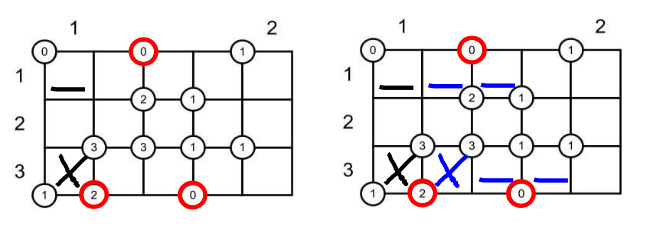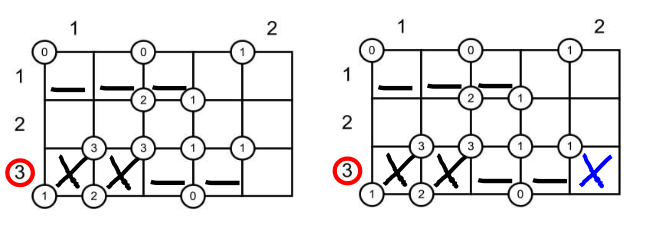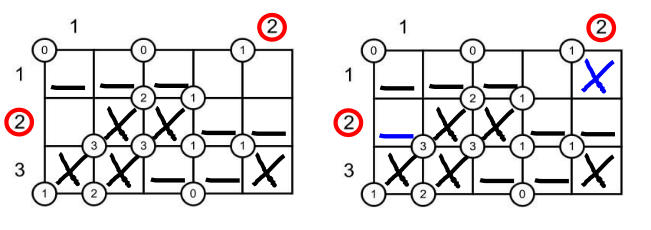Train your logical thinking with the Swamp Puzzles: You want to cross the swamp. Unfortunately your map is incomplete. The dangerous cells are not marked. But there are tips that can help you logically explore all the fields on the map:
To the left of some rows and above the columns is the number of unsafe cells in the respective row or column. In addition, circles in the field show how many of the neighboring cells are unsafe.
The safe, white fields form a coherent area. The cells only touch directly to the left, right, top or bottom.
So that you can pass through the area, mark all cells on the map:
- Swampy (dangerous) cells with an “X”
- Safe cells with a “_”
A Simple Example For The Start
In this small field the dangerous fields are not marked. Can you interpret the instructions correctly and find the safe cells?

Step 1

The two clues marked in red indicate that nothing must be marked in the top left corner and a cell must be marked in the bottom left. Both clues only have exactly one adjacent cell. In the illustration on the right, the two fields are supplemented in blue.
Additional tips can be evaluated at the edge: At the bottom of the field there is a circle with the number 2. These tips also only have two neighboring cells and can be solved directly. The same logic can be applied to two other tips. This results in the following field as an interim solution:
Step 2

In addition to the tips in the corners, other tips on the edges can often help early on.
The clues marked in red each have two adjacent cells. If the clue refers to zero or two cells, all adjacent cells are clearly explained. The example on the right shows the filled cells of the three tips. One cell was already filled.
Step 3

If the field is already partially solved, it is often worth taking a look at the row and column totals. These are to the left of the rows or above the columns. But these clues are not always present.
The third row contains three swampy cells. Two of these cells have already been found. A marker is still missing, but there is only one free cell left. This must therefore be dangerous.
Step 4

Now the tips can be evaluated in the field with four neighboring cells each. Two markings are already known for each of the two clues marked in red. For the tip with the “two”, it is clear from the two harmless cells that the two remaining cells must be swampy. The tip with the number “One” already has a swampy cell. The rest can be marked as safe.
Step 5

Additional rows and column totals are available for further solution. Only the first cell is missing in the middle row. This cell cannot be swampy because there are already two such cells in the row. The same reasoning works for the last column. Here, too, only one cell is missing that can be derived directly.
Step 6

The last missing cell that has not yet been solved can be derived using three rules. In the figure, all three clues are marked in red. The cell cannot belong to the swamp.
What kind of skill are trained by the Swamp Puzzles?
In order to solve these kind of exercises you have to reveal the unmarked cell by combining the different tips. In most cases the logical thinking skills are trained. In some situation you have to keep possible combination in your mind with trains the memory.
